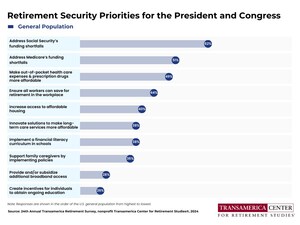LOS ANGELES, Feb. 3, 2015 /PRNewswire/ -- Millions of American workers may be missing out on a valuable tax credit this year. The Saver's Credit, also referred to as the Retirement Savings Contributions Credit by the Internal Revenue Service, is available to low- to moderate-income workers who are saving for retirement, yet just 24 percent of American workers with annual household incomes of less than $50,000 are aware of the credit, according to the 15th Annual Transamerica Retirement Survey.
"The Saver's Credit is a tax credit that reduces an eligible taxpayer's federal income tax, making it a meaningful incentive for low- to moderate-income individuals and households to save for retirement in a 401(k), 403(b), or IRA," said Catherine Collinson, president of nonprofit Transamerica Center for Retirement Studies. "Unfortunately, many eligible workers may be missing out on the Saver's Credit because they are unaware of it, including workers who have saved in a 401(k) or similar plan in 2014 who may miss it when filing their tax returns. Other workers might have saved had they known about it. For them, the good news is that it's not too late to contribute to an IRA and claim the Saver's Credit. You still have until April 15, 2015 to do so."
What is the Saver's Credit?
The Saver's Credit is a tax credit that may be applied to the first $2,000 of voluntary contributions an eligible worker makes to a 401(k), 403(b) or similar employer-sponsored retirement plan, or an IRA. The maximum credit is $1,000 for single and $2,000 for married couples.
"The Saver's Credit offers eligible workers the opportunity to reduce their federal income taxes. This tax credit is in addition to the ability to save on a tax-deferred basis in a 401(k) or similar plan or IRA. Many workers may be confusing these two retirement savings incentives," said Collinson.
Who Can Claim the Saver's Credit?
The credit is available to workers aged 18 years or older who have contributed to a company-sponsored retirement plan or IRA in the past year and meet the Adjusted Gross Income (AGI) requirements. Single filers with an adjusted income of up to $30,000 in 2014 or $30,500 in 2015 are eligible. For the head of a household, the adjusted income limit is $45,000 in 2014 or $45,750 in 2015. For those who are married and file a joint return, the adjusted income limit is $60,000 in 2014 or $61,000 in 2015. Additionally, the filer cannot be a full-time student or be claimed as a dependent on another person's tax return. For more details about eligibility, refer to this fact sheet.
How Can Workers Claim the Saver's Credit?
"Workers who are eligible to receive the Saver's Credit are at risk of missing it if they use the wrong tax form. The Saver's Credit is not available on Form 1040EZ," said Collinson. "If you are eligible to claim the Saver's Credit, you should use Form 1040, Form 1040A or Form 1040NR."
Some good news is that most workers who are eligible to claim the Saver's Credit are also eligible to take advantage of IRS' Free File program for taxpayers with an AGI of $60,000 or less. Fourteen software companies make their tax preparation software available for free through Free File at www.irs.gov/uac/Free-File:-Do-Your-Federal-Taxes-for-Free. Certain restrictions may apply.
Workers can take the following steps to claim the Saver's Credit:
- If you are using tax preparation software to prepare your tax return, including those programs offered through IRS' Free File program, use Form 1040, Form 1040A or Form 1040NR. The credit is not available with Form 1040EZ; however, the IRS has included instructions with the EZ form directing you to a different form if you choose to claim the credit. If your software has an interview process, be sure to answer questions about the Saver's Credit, also referred to as the Retirement Savings Contributions Credit and/or Credit for Qualified Retirement Savings Contributions.
- If you are preparing your tax returns manually, complete Form 8880, Credit for Qualified Retirement Savings Contributions, to determine your exact credit rate and amount. Then transfer the amount to the designated line on Form 1040, Form 1040A or Form 1040NR.
- If you are using a professional tax preparer, be sure to ask about the Saver's Credit.
- Consider having any refund you receive directly deposited to an IRA to further boost your retirement savings.
More information in English and Spanish can be found on the Saver's Credit page of TCRS' website or at www.irs.gov.
About Transamerica Center for Retirement Studies®
The Transamerica Center for Retirement Studies (TCRS) is a division of Transamerica Institute®, a nonprofit, private foundation. The Transamerica Institute is funded by contributions from Transamerica Life Insurance Company and its affiliates and may receive funds from unaffiliated third parties. For more information about TCRS, please refer to www.transamericacenter.org and follow TCRS on Twitter at @TCRStudies
About the 15th Annual Transamerica Retirement Survey of Workers
This survey was conducted online within the United States by Harris Poll on behalf of TCRS between February 21 and March 17, 2014 among 4,143 full-time and part-time workers of employers with 10 or more employees, including 1,427 with an annual household income of less than $50,000. Potential respondents were targeted based on employment status and company size. Respondents met the following criteria: U.S. residents, age 18 or older, full-time workers or part-time workers in for-profit companies, and employer size of 10 or more. Results were weighted as needed for the number of employees at companies in each employee size range.
Contact: Christy Warner
[email protected]
952-346-6271
Logo - http://photos.prnewswire.com/prnh/20140206/CG60189LOGO
SOURCE Transamerica Center for Retirement Studies
Related Links
http://www.transamericacenter.org
WANT YOUR COMPANY'S NEWS FEATURED ON PRNEWSWIRE.COM?
Newsrooms &
Influencers
Digital Media
Outlets
Journalists
Opted In





Share this article